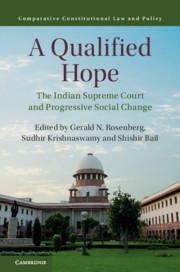Book contents
- A Qualified Hope
- Comparative Constitutional Law and Policy
- A Qualified Hope
- Copyright page
- Contents
- Notes on Contributors
- Foreword
- Acknowledgments
- Introduction
- Part I The Supreme Court of India – An Institutional Overview
- Part II The Supreme Court of India, Social and Political Mobilization
- Part III Welfare Rights and the Environment
- Part IV Discrimination
- Conclusion
- References
Conclusion
Neither a Silver Bullet Nor a Hollow Hope
Published online by Cambridge University Press: 19 August 2019
- A Qualified Hope
- Comparative Constitutional Law and Policy
- A Qualified Hope
- Copyright page
- Contents
- Notes on Contributors
- Foreword
- Acknowledgments
- Introduction
- Part I The Supreme Court of India – An Institutional Overview
- Part II The Supreme Court of India, Social and Political Mobilization
- Part III Welfare Rights and the Environment
- Part IV Discrimination
- Conclusion
- References
Summary
The preceding chapters explored the effects of leading decisions of the Indian Supreme Court on the lives of India’s marginalized citizens. They addressed the question of whether the Indian Supreme Court is an effective agent of progressive social change or is constrained in furthering the rights of the relatively disadvantaged. We suggested in thethat the Indian Supreme Court might be capable of playing a progressive role because it has several advantages that other national high courts, particularly the US Supreme Court, lack. These include the broad sweep of constitutional rights in the Indian Constitution, the procedural improvisations the Court has made such as its public interest litigation (PIL) docket, its suo moto jurisdiction, its continuing mandamus process, and its heightened structural independence from the other branches of the central government. These suggest that Indian Supreme Court decisions might have the ability to make a real difference in the lives of India’s most disadvantaged citizens.
- Type
- Chapter
- Information
- A Qualified HopeThe Indian Supreme Court and Progressive Social Change, pp. 345 - 358Publisher: Cambridge University PressPrint publication year: 2019

